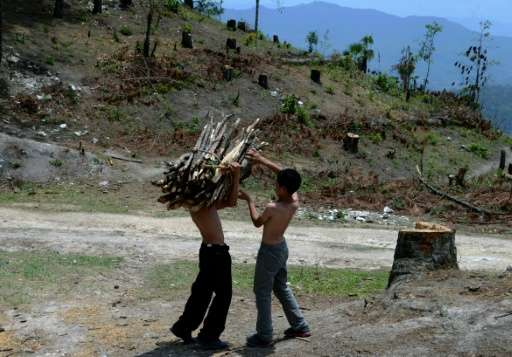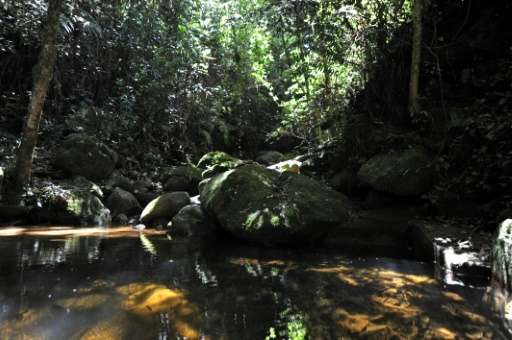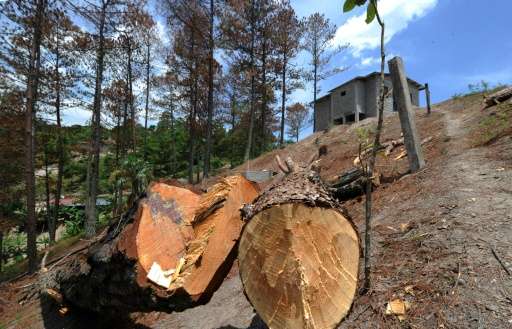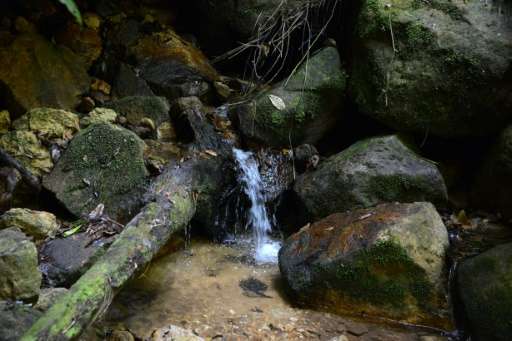Shock as Honduras national park cleared to halt bugs

A massive bug infestation and cut-down of pine trees in a national park in Honduras has stunned residents and sparked a warning from experts that a localized spike in temperatures will ensue.
Authorities are clearing huge swathes of forest in La Tigra National Park, seven kilometers (five miles) northeast of Tegucigalpa, in an effort to stop the plague of bark-munching southern pine beetles.
The park, which serves as green "lungs" and a cooling zone for the city, is nearly 240 square kilometers (93 square miles)—and 10 percent of it has been chopped down over the past nine months.
"This has caused a big shock," said Jorge Murillo, a coordinating biologist for the scientific research program studying the park's diverse flora and fauna.
The result will be "less water and higher temperatures, as well as biological aspects we will have to take into account," he added.
Honduras' state Forest Conservation Institute (ICF) has been forced to cut down beetle-infested trees as well as healthy ones, to create a buffer against the insects, which can fly 100 meters (yards).
Yet, despite the tree-clearing operation carried out with help from chainsaw-wielding soldiers, the infestation has covered far more territory than expected and continues to expand.

It's not only the nature reserve that is affected: the southern pine beetle has already destroyed more than 600,000 hectares (one million acres) of pine forest, or nearly a quarter of the country's primary forest cover.
Flying over the Central American country, one can see vast expanses of dying forest—colored brown or red—in sharp contrast with the green of healthy trees, predominantly conifers.
A wasteland
La Tigra park boasts a mountain from which run more than 70 creeks carrying water used by nearly a third of Tegucigalpa's one million residents. Its vegetation processes some of the exhaust fumes from the city's 800,000 vehicles.
Hondurans living on its outskirts have suddenly found their homes, dozens of which once nestled under canopies of green, laid bare on a wasteland.
Alcides Hernandez, a former director of the post-graduate economy department of the National University, noted that, before the bug invasion, rural residents "couldn't cut even a pine tree branch because they would be arrested."
He described the devastation of Honduras' forests as a disaster.

Hernandez had started a cybercafe in the middle of what had been a picturesque pine grove. But the insects passed through, ravaging the four hectares of trees, and he was forced to close the business.
Murillo, the biologist, said: "This problem has struck us to our souls, and it's like this across the country."
The culprit, the southern pine beetle, is no bigger than a grain of rice. A female can lay 50 eggs at a time, and thousands hatch under the bark of a stricken tree, which inevitably succumbs.
The insects have always been present in Honduras, but in far smaller numbers.
Specialists attribute the sudden explosion in the beetles' population to a drought that has gone on for three years now. It is attributed to the cyclical El Nino weather phenomenon.
Those fighting the losing war against critter have likened it to a cancer that is eating away at the Honduras' tree cover.

A national emergency
Lucky Medina, an environmental advisor to the military, told AFP that 16 of Honduras' 18 provinces have been infected by the plague since it started last year.
The 600,000 hectares that have been ravaged represent around a third of the coniferous forest of the entire country, he said.
The government has declared the situation a national emergency so that resources can be freed up to immediately try to counter detected outbreaks in new zones.
The ICF, in charge of tackling the plague, has deployed 2,500 people to affected areas.
But they are not enough, Medina said.
"More than double that is needed—and even with that it would be difficult to bring under control."
He estimated it will take at least five decades to restore the damaged zones. And during that time, the next two generations of Hondurans will suffer severe climatic effects.
© 2016 AFP

















